| Archiv Klaus Kramer Ironclads - the Floating Fortresses of the American Civil War The first Crucial Test of Ironclads (Selection) |
||||||||||||||||||||||||||||
|
|
||||||||||||||||||||||||||||
 |
||||||||||||||||||||||||||||
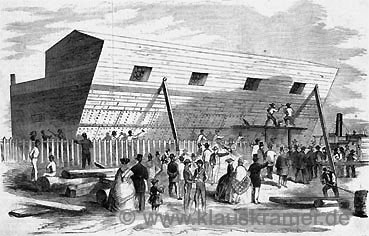 |
||||||||||||||||||||||||||||
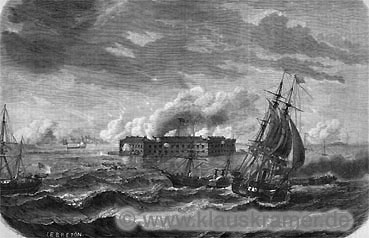 |
||||||||||||||||||||||||||||
| Construction of a swimming battery in 1861, in the harbor of Charleston. Engraving SG000675 | ||||||||||||||||||||||||||||
| 1861. Bombardement of Fort Sumter - the beginning of the american Civil War. Engraving SG000672 | ||||||||||||||||||||||||||||
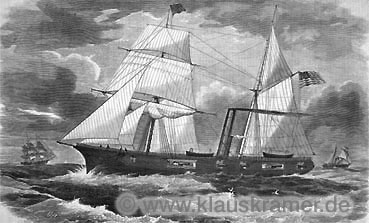 |
||||||||||||||||||||||||||||
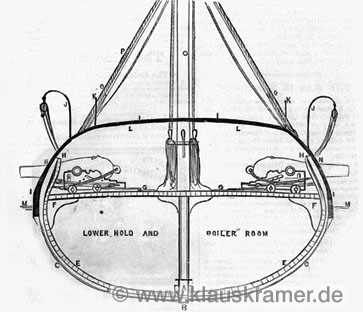 |
||||||||||||||||||||||||||||
| The ironclad WAR-STEAMER was built in Mystic, since 1861. Connecticut: L.o.a. 200 feet, breadth 36 feet and 6 inches. Engraving SG000668 | ||||||||||||||||||||||||||||
| Midship section oft an ironclad ship, 1861. The dark part means iron plating. Engraving SG000670 | ||||||||||||||||||||||||||||
 |
||||||||||||||||||||||||||||
| The fleet of the United States in the barbor of Pensacola. From left to right: steam sloop BROOKLYN, 25 guns; frigate SABINE, 50 guns; sloop ST. LOUIS, 22 guns. Engraving 1861. SG000818 | ||||||||||||||||||||||||||||
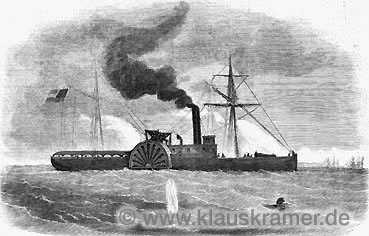 |
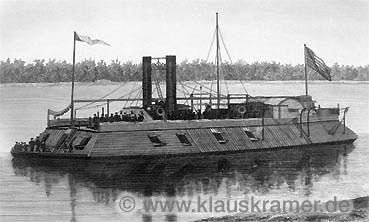 |
|||||||||||||||||||||||||||
|
St. Louis in October 1861. The first US ironclad ST. LOUIS "the ironclad 'Pook-Turtle' was built in 45 days. The floating fortresses was named for its constructor Samuel M. Pook. Few days later they had built a lot of sisterships: CARONDELET, CINCINNATI, LOUISVILLE, MOUND CITY, CAIRO and PITTSBOURH. Engraving. SG000695
|
||||||||||||||||||||||||||||
|
Ironclad paddle steamer YORKTOWN of the rebel-army. Launched in 1861. L.o.a. 250 feet, breath 34 feet. Engraving. SG000678
|
||||||||||||||||||||||||||||
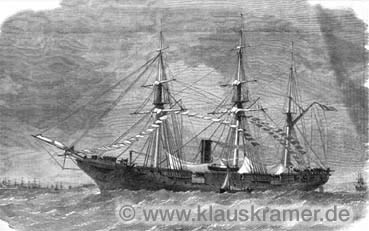 |
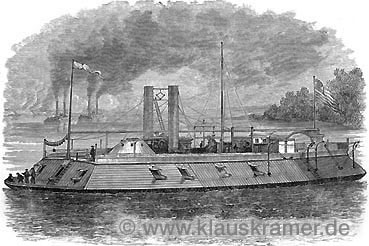 |
|||||||||||||||||||||||||||
| Both parts of the american Civil War tried to stop the supply of the adversary. The federal sloop-of-war TUSCARORA in Southamton water. Engraving 1862. SG000810 |
The floating fortresses of St. Louis-class were all identicly, just coloured marks helped to differ them. Those "Thunder Mountain" were 175 feet long and they had a breath of 52 feet. Engraving SG000693
|
|||||||||||||||||||||||||||
 |
||||||||||||||||||||||||||||
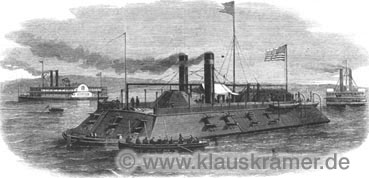 |
||||||||||||||||||||||||||||
| The capture of New Orleans: The two rebell-Ironclads ANGLO-NORMAN and MISSISSIPPI on fire. Engraving 1862. SG000820 | ||||||||||||||||||||||||||||
| Federal gun-boat. Engraving 1862. SG000784 | ||||||||||||||||||||||||||||
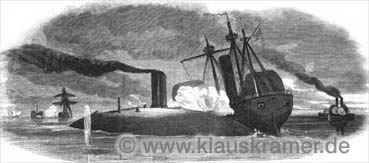 |
||||||||||||||||||||||||||||
 |
||||||||||||||||||||||||||||
| The war in the lower Mississippi: The famous rebel steam ram MANASSAS endeavoring to sink the U.S. steamer MISSISSIPPI by running into her. Engraving 1862. SG000822 | ||||||||||||||||||||||||||||
| The Civil War in the south-west: The rebell steam ram MANASSAS, abandoned and on fire, after the great naval fight in April, 1862. Engraving SG000821 | ||||||||||||||||||||||||||||
 |
||||||||||||||||||||||||||||
| The foretop of U.S. war steamer MISSISSIPPI during the conflict in Mississippi River, May 1852. Engraving SG000819 | ||||||||||||||||||||||||||||
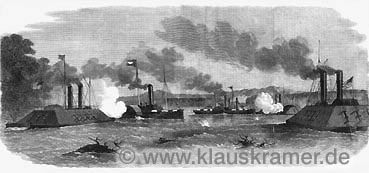 |
||||||||||||||||||||||||||||
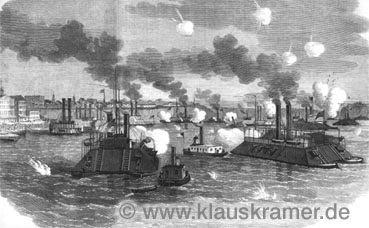 |
||||||||||||||||||||||||||||
| 1862 - engagement in Mississippi River, between federal and confederate gun-boats. That was near Fort Pillow, 75 miles from Memphis. Engraving SG000669 | ||||||||||||||||||||||||||||
| Destruction of the confederate flotilla near Memphis. Engraving SG000780 | ||||||||||||||||||||||||||||
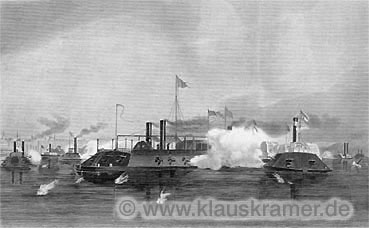 |
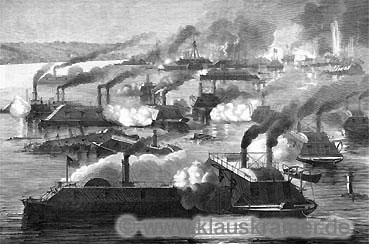 |
|||||||||||||||||||||||||||
| June 1862 - naval battle between the US Navy and the rebels. Action of the ironclad- and ram ships near Memphis in Mississippi River. Engraving SG000681 | ||||||||||||||||||||||||||||
| Memphis in Jule 1862 - naval battle in the Mississippi. Engraving SG000668 | ||||||||||||||||||||||||||||
 |
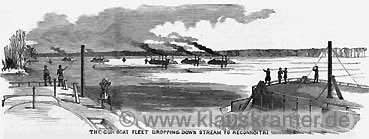 |
|||||||||||||||||||||||||||
|
Mortar boats in process of construction in St. Louis. They should captured the 'Island No. 10' The boats were 60 feet long and 25 feet whide. Ironplates protected the outher skin. Engraving, 1862. SG000686
|
||||||||||||||||||||||||||||
|
The gun-boats are going in position at 'Island No. 10'. Engraving SG000682
|
||||||||||||||||||||||||||||
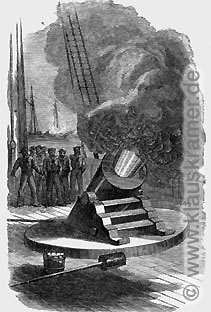 |
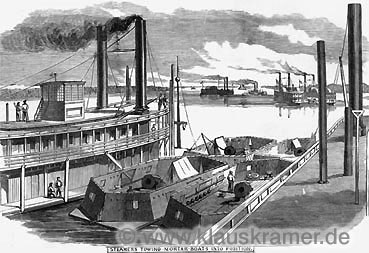 |
|||||||||||||||||||||||||||
| A mortar of a gun-boat in Mississippi River. It weighed 17.210 pounds, the foundation about 4.500 pounds. The with sand filled cannonball was 230 pounds heavy. Engraving 1862. SG000685 | ||||||||||||||||||||||||||||
|
Steamers towing Mortar-boats into position. 1862. Engraving SG000683
|
||||||||||||||||||||||||||||
 |
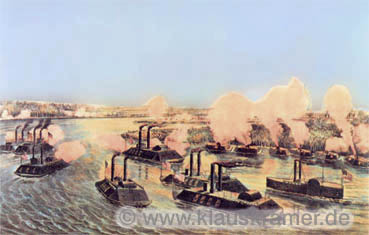 |
|||||||||||||||||||||||||||
| Bombardment and conquest of 'Island Number Ten' by Ironclads of the US Army. Lithographie by Currier&Ives, 1862 L03285307 | ||||||||||||||||||||||||||||
|
Operation against Island No. 10 in March 1862. Engraving SG000684
|
||||||||||||||||||||||||||||
 |
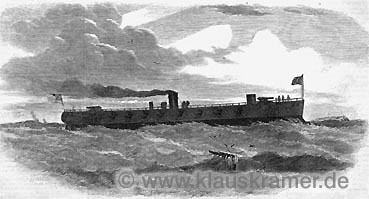 |
|||||||||||||||||||||||||||
| Thomas Fitch Rowland, builder of multidude of monitors and turret-ships of the US Navy. Engraving 1862 SG000687 | USS Ironclad frigate IRONSIDES, in fighting trim. The ship was built in 1862. Engraving SG000656 | |||||||||||||||||||||||||||
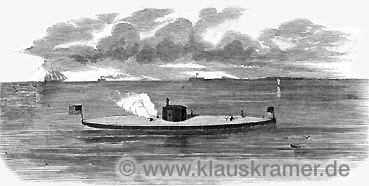 |
 |
|||||||||||||||||||||||||||
|
USS ONONDAGA, 226 feet long. Engraving SG000718
|
||||||||||||||||||||||||||||
| USS MONITOR, 172 feet long. Engraving SG000720 | ||||||||||||||||||||||||||||
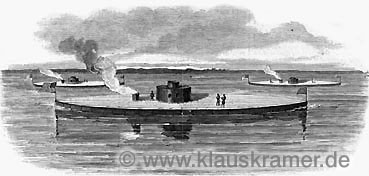 |
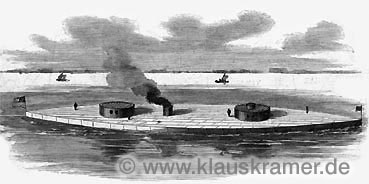 |
|||||||||||||||||||||||||||
| USS PASSAIC, 200 feet long. Engraving SG000715 | USS PURITAN, 340 feet long. Engraving SG000721 | |||||||||||||||||||||||||||
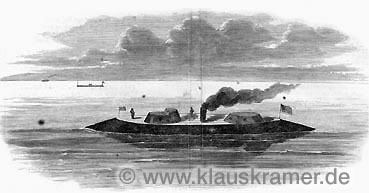 |
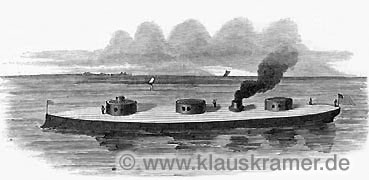 |
|||||||||||||||||||||||||||
|
USS WOODNA, 150 feet long. Engraving SG000719
|
||||||||||||||||||||||||||||
|
USS ROANOKE, 270 feet long. Engraving SG000716
|
||||||||||||||||||||||||||||
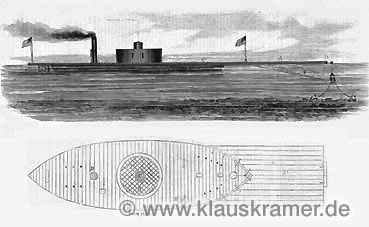 |
||||||||||||||||||||||||||||
 |
||||||||||||||||||||||||||||
|
The monitores set in arrester gears for protection of John Ericsson's sea mines, called Ericsson Devils. Engraving SG000664
|
||||||||||||||||||||||||||||
| The ironclad Navy. From left to right: USS PURITAN, USS CATSKILL, USS MONTAUK, USS WOODNA, USS PASSAIC, USS ROANOKE, USS WINONA, USS IRONSIDES, NAUGATUCK, USS BROOKLYN, USS MONITOR. Engraving September, 1862. SG000714 | ||||||||||||||||||||||||||||
 |
 |
|||||||||||||||||||||||||||
|
Dahlgreen-cannons in the turret of the turret-ship USS PURITAN. Engraving SG000660
|
||||||||||||||||||||||||||||
| Bombardment of fort McAllister by the US-iron-clad fleet in March 1863. Engraving SG000831 | ||||||||||||||||||||||||||||
 |
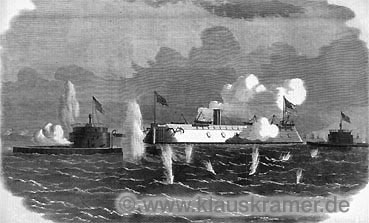 |
|||||||||||||||||||||||||||
|
April 7. 1863 - Attack on Fort Sumter, near Charleston by nine Ericsson-batteries under rear-admiral Du Pont. Engraving SG000680
|
The big Ironclad USS NEW IRONSIDES and two Ericson-batteries going into action at Charleston in April 7. 1863. Engraving SG000673
|
|||||||||||||||||||||||||||
 |
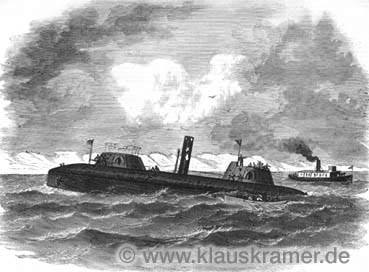 |
|||||||||||||||||||||||||||
|
The ironclad USS KEOKUK in the first days of April 1863, just before launching. Engraving 1863. SG000666
|
April 8. 1863, some days later the iron-clad KEOKUK is sinking on the morning after the battle at Charleston, South Carolina. Engraving SG000835 | |||||||||||||||||||||||||||
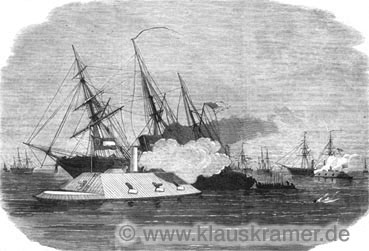 |
||||||||||||||||||||||||||||
| Attack on the US blockading squadron off Charleston by Ironclad gun-boats, 1863. Engraving SG000784 | ||||||||||||||||||||||||||||
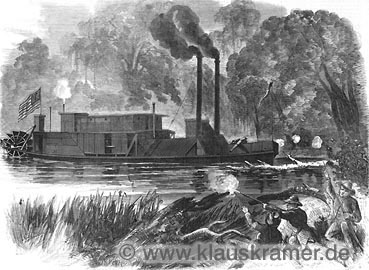 |
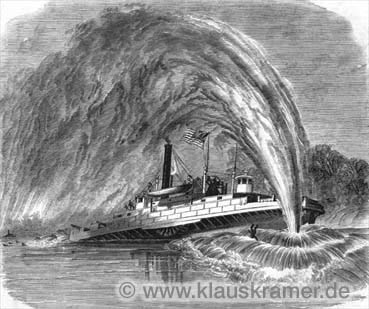 |
|||||||||||||||||||||||||||
| The Ironclad BARRATARIA snagged in Amite River, Los Angeles, attacked by rebel guerrillas. Engraving 1863 SG000781 | The strong iron plating made the ships nearly invulnerable. This fact was the trigger to develop torpedos and underwater mines, which can wound the ironclads under the waterline. August 1863 - total demolition of the Ironclad COMMODORE BARNEY by a torpedo in James River. Engraving L3032168 |
|||||||||||||||||||||||||||
 |
||||||||||||||||||||||||||||
| Explosion of a torpedo under the bow of the United States gun-boat COMMODORE BARNEY in the James River. Engraving L3032168 | ||||||||||||||||||||||||||||
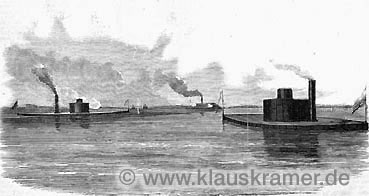 |
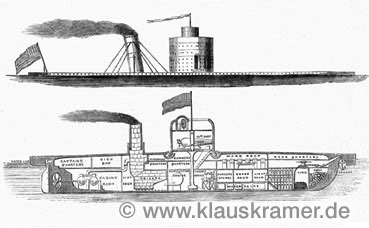 |
|||||||||||||||||||||||||||
| In June 1863 - Capture of a confederate steamer by the U.S. Monitor WEEHAWKEN in the Warsaw-Sund. Engraving SG000677 | The U.S. gun-boat WEEHAWKEN, one of the ironclads engaged in the bombardment of Chaleston. Engraving 1863. SG000783 | |||||||||||||||||||||||||||
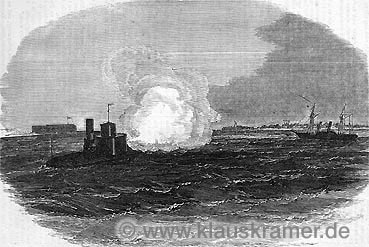 |
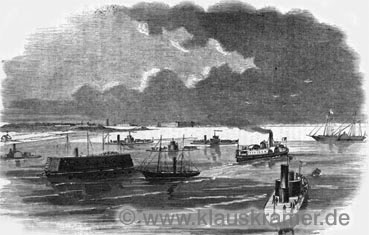 |
|||||||||||||||||||||||||||
|
The ironclad CATSKILL sinking a blockade runner under sumter's guns in July 1863. Engraving SG000690
|
July 1863 - ironclads by the exchance of pristoners under a flag of truce, in Charleston Harbor. Engraving SG000692
|
|||||||||||||||||||||||||||
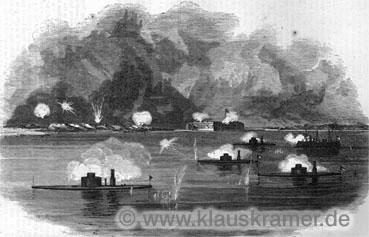 |
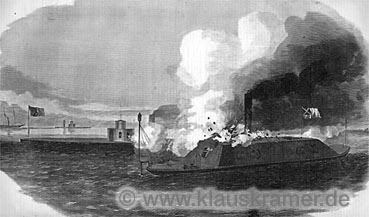 |
|||||||||||||||||||||||||||
|
US ironclad turret-ships bombarded Fort Wagner in Charleston, South Carolina. Engraving 1963. SG000691
|
Capture of the rebel ironclad CSS ATLANTA by the Monitor USS WEEHAWKEN under Captain Rodgers. Engraving SG000674
|
|||||||||||||||||||||||||||
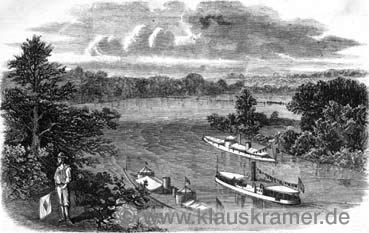 |
||||||||||||||||||||||||||||
| Siege of Richmond - View from the crow nest battery, showing the obstructions to prevent the descent of the rebel rams, and the monitors below them. Engraving 1864. SG000834 | ||||||||||||||||||||||||||||
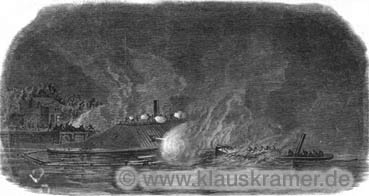 |
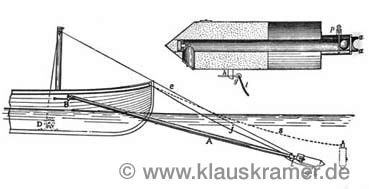 |
|||||||||||||||||||||||||||
| A brilliant naval exploit - destruction of the rebel ram ALBEMALE, in Roanoke River, on night of October 27. 1864, by a torpedo boat, under command of Lieut. William B. Cushing, U.S.N. Engraving SG000833 | The torpedo and the lauch. Engraving L03032220 | |||||||||||||||||||||||||||
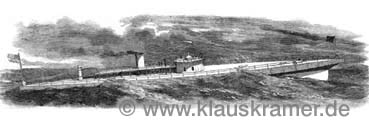 |
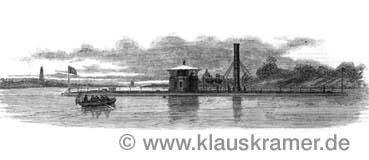 |
|||||||||||||||||||||||||||
| The new ocean ironclad DICTATOR. Engraving 1864. SG000826 | The new light draught US-monitor TUNIX. Engraving 1864. SG000829 | |||||||||||||||||||||||||||
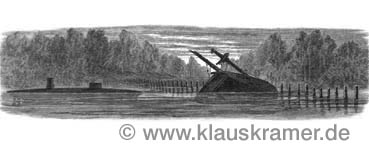 |
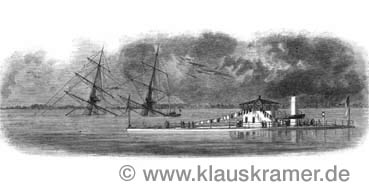 |
|||||||||||||||||||||||||||
| One of the new US torpedo boats. Engraving SG000828 | The sinking of the rebel war steamer FLORIDA, near fortress MONROE, November 28 1864. Engraving SG000833 | |||||||||||||||||||||||||||
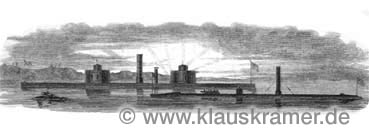 |
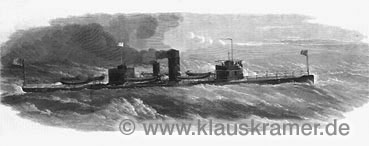 |
|||||||||||||||||||||||||||
| The double-turreted US-monitor MONADNOCK and the monitor torpedo boat NAPA strpped for action. Engraving 1864. SG000663 | The ironclad USS MONADNOCK in December 1864. Engraving 1864. SG000663 | |||||||||||||||||||||||||||
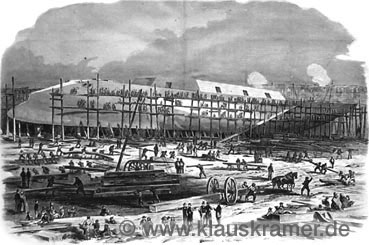 |
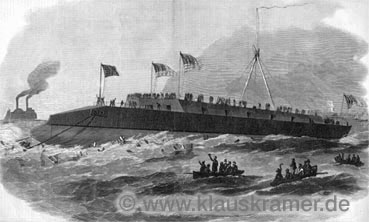 |
|||||||||||||||||||||||||||
|
The ironclad steam ram DUNDERBERG under construction 1893. The ship was the greatest man-of-war in the world. The big warship was built by the William H. Webbs shipyard in New York. Engraving SG000713
|
The launch of the ironclad DUNDERBERG after the war in July 1865. Engraving 1865. SG000667
|
|||||||||||||||||||||||||||
 |
||||||||||||||||||||||||||||
| Ironclad USS DUNDERBERG, launched 1865 after the end of the war. Engraving SG000704 | ||||||||||||||||||||||||||||
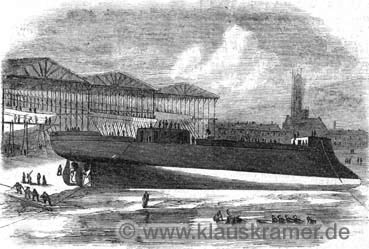 |
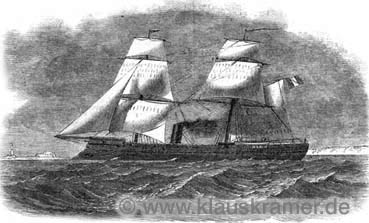 |
|||||||||||||||||||||||||||
| The launch of the new ironclad ram SPHINX (later the CCS STONEWALL) at June 21. 1864 on the Arman shipyard in Bordeaux/France. Engraving SG000704 | At first he SPHINX was ordered by the confedered navy. The French government forbade the sale to the Confederacy, and she was sold to Denmark for the war against Prussia. Because the Danish war was over the Danes would not accept her and the ship was sold to the Confederate States. The ship was named STONEWALL in December 1864. SG000704 | |||||||||||||||||||||||||||
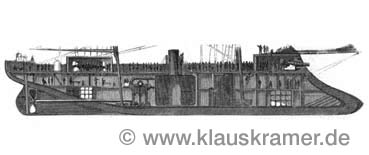 |
||||||||||||||||||||||||||||
| A section of the new french iron-clad ram SPHINX (later CSS STONEWALL). Engraving SG000825 | ||||||||||||||||||||||||||||
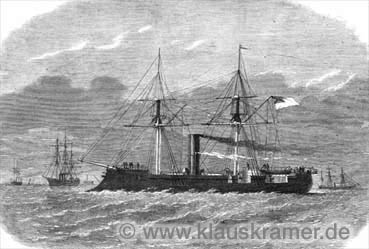 |
||||||||||||||||||||||||||||
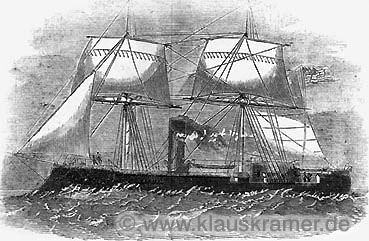 |
||||||||||||||||||||||||||||
|
The steam ram CSS STONEWALL. Engraving SG000706
|
||||||||||||||||||||||||||||
| The ironclad rebel steam ram STONEWALL leaving the harbor of Lisbon, to cut off the adversative european supply. Engraving SG000816 | ||||||||||||||||||||||||||||
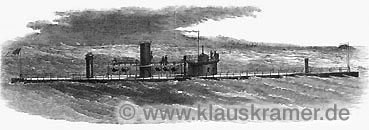 |
||||||||||||||||||||||||||||
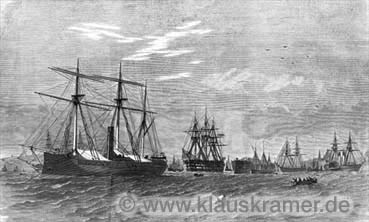 |
||||||||||||||||||||||||||||
|
Ironclad ram USS DICTATOR, launched 1863. Designed by John Ericsson. Engraving SG000711
|
||||||||||||||||||||||||||||
| The british war steamer MAJESTIC, watching the rebel rams in the Mersey River, England. Engraving SG000817 | ||||||||||||||||||||||||||||
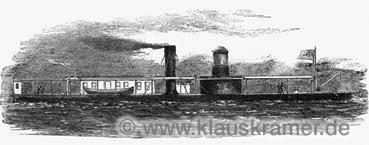 |
||||||||||||||||||||||||||||
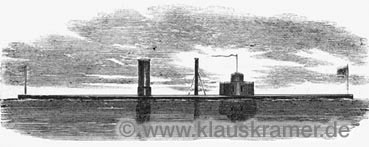 |
||||||||||||||||||||||||||||
|
Ironclad USS OZARK. At that time three ships of this class were built. Engraving SG000709
|
||||||||||||||||||||||||||||
|
Ironclad USS MANAYUNK. Eleven ships of this type, for river- and harbor defensiveness, were built for the US-Navy. Engraving SG000710
|
||||||||||||||||||||||||||||
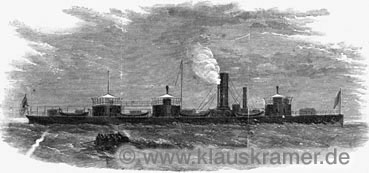 |
||||||||||||||||||||||||||||
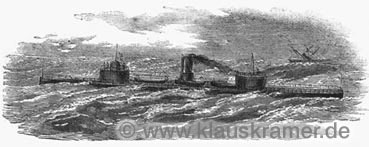 |
||||||||||||||||||||||||||||
|
The United States Frigate ROANOKE with three Ericsson-towers, launched in 1863. Engraving SG000712
|
||||||||||||||||||||||||||||
|
Ironclad battery USS ONONDAGA with two towers and four guns, launched 1863. Engraving SG000708.
|
||||||||||||||||||||||||||||
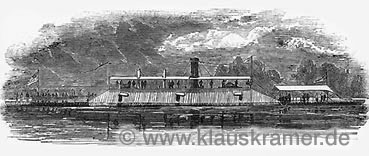 |
||||||||||||||||||||||||||||
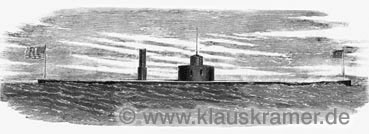 |
||||||||||||||||||||||||||||
| Nine ironclads of the WEEHAWKEN-type came into being 1862 for the US-Navy. Engraving SG000705 | ||||||||||||||||||||||||||||
| The ATLANTA, was originally developed for the rebels. 1863 the ship was captured by the US-troupes. Engraving SG000703 | ||||||||||||||||||||||||||||
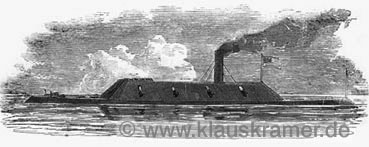 |
||||||||||||||||||||||||||||
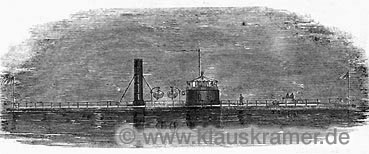 |
||||||||||||||||||||||||||||
| The TENNESSEE, a typically "Thunder Mountain" of the rebels, was capture by the confederate and battled for the US-Navy. Engraving SG000701 | ||||||||||||||||||||||||||||
| Twenty ships of the YAZOO-type were built for the US Navy. Engraving SG000702 | ||||||||||||||||||||||||||||
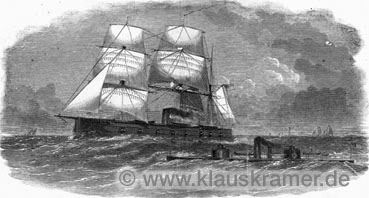 |
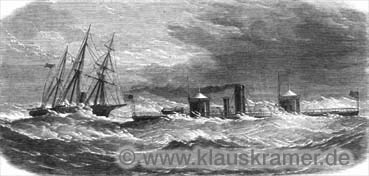 |
|||||||||||||||||||||||||||
| The federal US-ironclad MONADNOCK towing a disabled gun-boat in a storm of Cape Hatteras. Engraving 1865. SG000815 | ||||||||||||||||||||||||||||
| The USS NEW IRONSIDES, launched 1836 and torret-ship USS MONADNOCK, launched in 1864, at sea. Engraving SG000700 | ||||||||||||||||||||||||||||
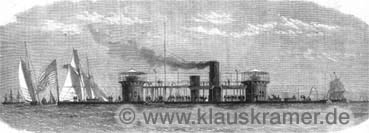 |
||||||||||||||||||||||||||||
| The US turret-ship MIANTONOMAH. Engraving 1866. SG000811 | ||||||||||||||||||||||||||||
 |
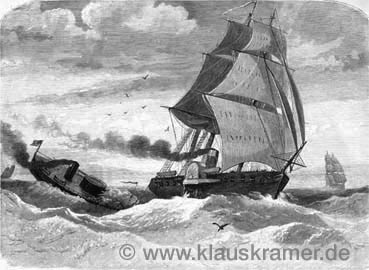 |
|||||||||||||||||||||||||||
|
The US-steamer POWHATAN towing the rebel-Monitor SAUGUS. Engraving SG000628
|
||||||||||||||||||||||||||||
|
Interior view of the Ericsson turret, about 1866. Engraving SG000707
|
||||||||||||||||||||||||||||
| << USS MONITOR against MERRIMAC | ||||||||||||||||||||||||||||
|
|
||||||||||||||||||||||||||||